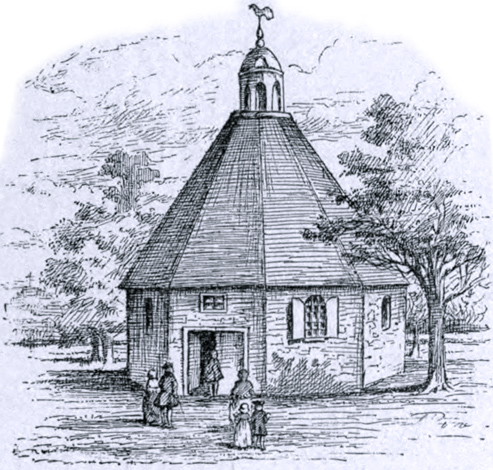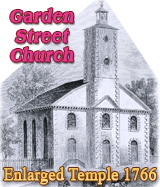
Garden Street Church

The Garden Street Church, later Old Dutch Church, later South Dutch Church had its roots in the Dutch Reformed Church of New Amsterdam (now New York), originally established in 1628, during the Dutch rule.
In 1633, the first Reformed Dutch Church temple was erected on what is now the north side of Pearl Street, between Whitehall and Broad streets. In 1642, a stone temple was built inside the fort, the St. Nicholas Church. In 1664, the English took over New Amsterdam and renamed it New York. The Dutch were allowed their religious freedom, but the church in the fort was appropriated by the English.
The Reformed Dutch Church began to erect a new temple, after March 1692, on Garden Street (now Exchange Place). It was under construction in October.
The bell was cast in 1674. The Garden Street Church was larger than the old one and opened for divine service in the early 1693, before it was thoroughly finished. The tower was added in 1696. The society was known as the Garden Street Church.
Note on the street name: during the Dutch rule, this street was known as "Tuyen Straat" (in modern Dutch Tuinstraat can be translated as Garden Street). It became Church Street in 1695, Garden Street in 1797 and Exchange Place in 1827.
An illustration of this original temple on Garden Street (on the right), drawn by H. Rosa, was published in The Empire State: a Compendious History of the Commonwealth of New York by Benson John Lossing, 1887. The following text accompanies this engraving: «This little structure was built of wood, octagonal in form, with a very high, steep roof, and a cupola in the centre of it surmounted by a "weather-cock". It was enlarged and repaired in 1776 [1766?], and was rebuilt of stone in 1807. It stood upon a lane extending eastward from Broad Street parallel with Wall Street. The grounds on the lane were neatly laid out and well cultivated, and it received the name of "Garden Lane," and finally Garden Street, now Exchange Place. When it was built, in 1693, it was considered rather too far out of town.»
In 1696, the Church was incorporated under a charter granted by King William III of England as Collegiate Church.
Thomas DeWitt (A Discourse Delivered in the North Reformed Dutch Church in the City of New-York, ... 1856), wrote: «I find in a manuscript the following reference to the style of the building of the old church in Garden street. It was an oblong square, with three sides of an octagon on the east side [see illustration on the right]. In the front it had a brick steeple, on a large square foundation, so as to admit a room above the entry for a consistory room. The windows of the church were small panes of glass set in lead. The most of them had coats of arms of those who had been elders and magistrates, curiously burnt on glass by Gerard Duyckinck. Some painted coats of arms were also hung against the walls. This house continued the only house of worship for our Dutch ancestors, till the building of another at the corner of Nassau and Liberty streets [the Middle Dutch Reformed Church, 1729]. After the erection of the church in Nassau street, the church in Garden street took the name of the Old, and in Nassau street that of the New ; and when the church at the corner of Fulton and William was erected [North Dutch Church, 1769], it took the name of the north, when the Garden-Street Church was designated as the SOUTH, and the Nassau-Street as the MIDDLE. The terms old and new, however, continued to be applied to the two latter for a long time subsequent.»
On December 25, 1697, Revered William Vesey, the first rector of Trinity Church, was inducted into office by Governor Fletcher in the Dutch Church in Garden Street, as the Trinity Church building was under construction. The Episcopal congregation was given the use of the Dutch Church for about three months, until their temple was ready for use in March of the following year.
 In
1766 the temple was enlarged and repaired and used as hospital by the
British during the Independence War. In 1807, a new temple was erected on the same site,
then the South Dutch Church. In
1812, the South Church was separated from the Collegiate Church.
In
1766 the temple was enlarged and repaired and used as hospital by the
British during the Independence War. In 1807, a new temple was erected on the same site,
then the South Dutch Church. In
1812, the South Church was separated from the Collegiate Church.
The second temple burned in the Great Fire of 1835 and the congregation built a new temple on Murray Street, where they remained until 1847. The ground belonging to the South Reformed Dutch Church in Exchange Place was sold on June 14, 1836.
The congregation moved to a Gothic revival temple on Fifth Avenue and 21st Street, completed about 1849. In 1890, the South Church sold this temple and purchased the former Zion Protestant Episcopal Church, a Gothic edifice built in 1854, located on Madison Avenue at 38th Street.
In 1914, the South Reformed Dutch Church was dissolved and the remaining congregation merged with the First Union Presbyterian Church, which became known as the Park Avenue Presbyterian Church.
The original Reformed Dutch Church on Garden Street, built in 1693 by H. Rosa. Source: The Empire State: a Compendious History of the Commonwealth of New York by Benson J. Lossing, 1887. It seem, however, that this engraving fails to represent its oblong design as observed in the map below.
Fragment of the John Miller's map, dated 1695, showing the original temple at Church Street (now Exchange Place), with additional text in red: "an oblong square, with three sides of an octagon on the east side".

First temple built in 1693
|
Copyright © Geographic Guide - Old NYC. Historic Dutch Churches. |
Garden Street Church